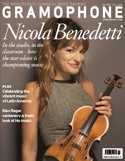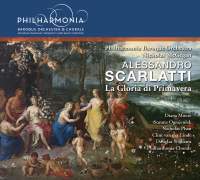Texte paru dans: / Appeared in: |
|
|
Outil de traduction (Très approximatif) |
|
|
Reviewer:
David Vickers
The serenata La gloria di Primavera (1716) was commissioned by the Neapolitan Duke Nicola Gaetani dell’Aquila d’Aragona for his wife Aurora Sanseverino, although the libretto by her secretary Nicola Giuvo was designed as an expedient celebration of the birth of the Habsburg Archduke Leopold, son of Holy Roman Emperor Charles VI (who had gained the kingdom of Naples as part of the severance package that concluded the War of Spanish Succession). Therefore Alessandro Scarlatti’s music was created for the same circle of patrons in Naples, and in collaboration with the same poet, as Handel’s Aci, Galatea e Polifemo (1708); the superhuman bass Antonio Manna who sang Jupiter had most likely been Handel’s first Polifemo eight years earlier. The first performance, on May 19, 1716, also featured the soprano Margherita Durastanti (Handel’s first Agrippina). The four seasons hold a contest to establish supremacy as the most important to the new-born prince; after the triumph of Spring, Jupiter leads the collective prophecy of the coming of a new golden age (as it turned out, the infant Leopold died only a few months afterwards).
Scarlatti’s paean is captured in Nicholas McGegan’s live recording made in Berkeley in October 2015. The Philharmonia Baroque Orchestra’s string-playing is routinely urbane, and the continuo group’s realisations are impeccably shaded. Diana Moore is expressive with words and musical details in Spring’s splendid arias, such as ‘Canta dolce il rosignuolo’ (in which woodwinds sweetly imitate a nightingale’s song). Suzana Ograjen≈ek’s lightly supple timbre, intelligent treatment of melismatic word-setting and lovely melodic phrasing are applied adroitly to Summer’s ‘Fa che Zeffiro tra fronde’ (a rapt description of breezes wafting through trees and grasses, featuring whispering strings and solo flute). Clint van der Linde sings sensitively, albeit with occasional frailty; Autumn’s pastoral ‘Fuor dell’urna le bell’onde’ has beguiling exchanges between murmuring concertante upper and lower strings, whereas the countertenor shows a steelier heroic ability in the trumpet aria ‘L’offra sempre in pace’. Nicholas Phan’s precise florid passagework in ‘Di cieco orrore e d’ombra’ is one of Winter’s gutsier outbursts, although he also has the softly mellifluous ‘Sull’orme de’ grand’Avi’ (with a gentle pair of oboes).
There are also several fine
ensembles for the seasons, such as solemn minor-key quartets invoking Jupiter –
whose appearance in Part 2 has a theatrical impact thanks to Douglas Williams’s
resonance and mastery across a wide-ranging tessitura. Quibbles such as a poor
choice about where to break between the two discs and minor hyperbolic lapses in
an otherwise excellent booklet-note are dissolved by McGegan’s experienced
direction and the musical finesse of his Californian orchestra. This is a
delightfully enjoyable revelation of the elder Scarlatti’s genius. |
|
|
Consultez d'autres mois / Browse other months
|
|
|
|
|
|
Cliquez l'un ou l'autre
bouton pour découvrir bien d'autres critiques de CD |
|




